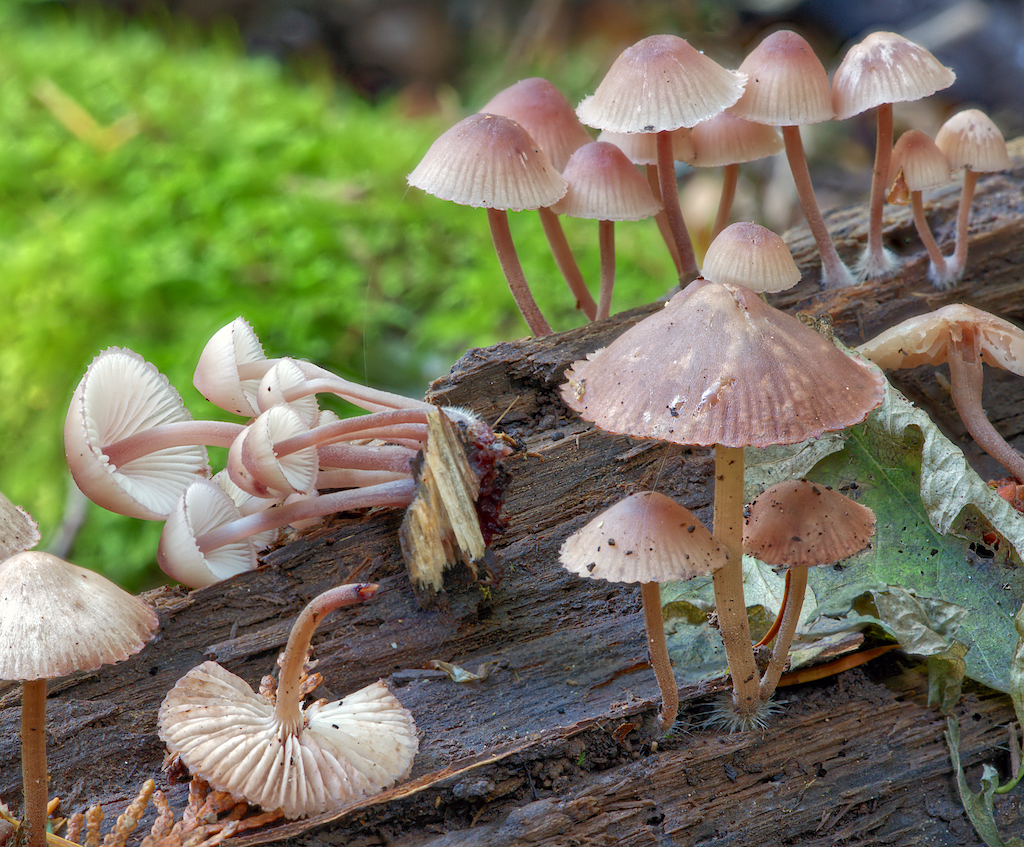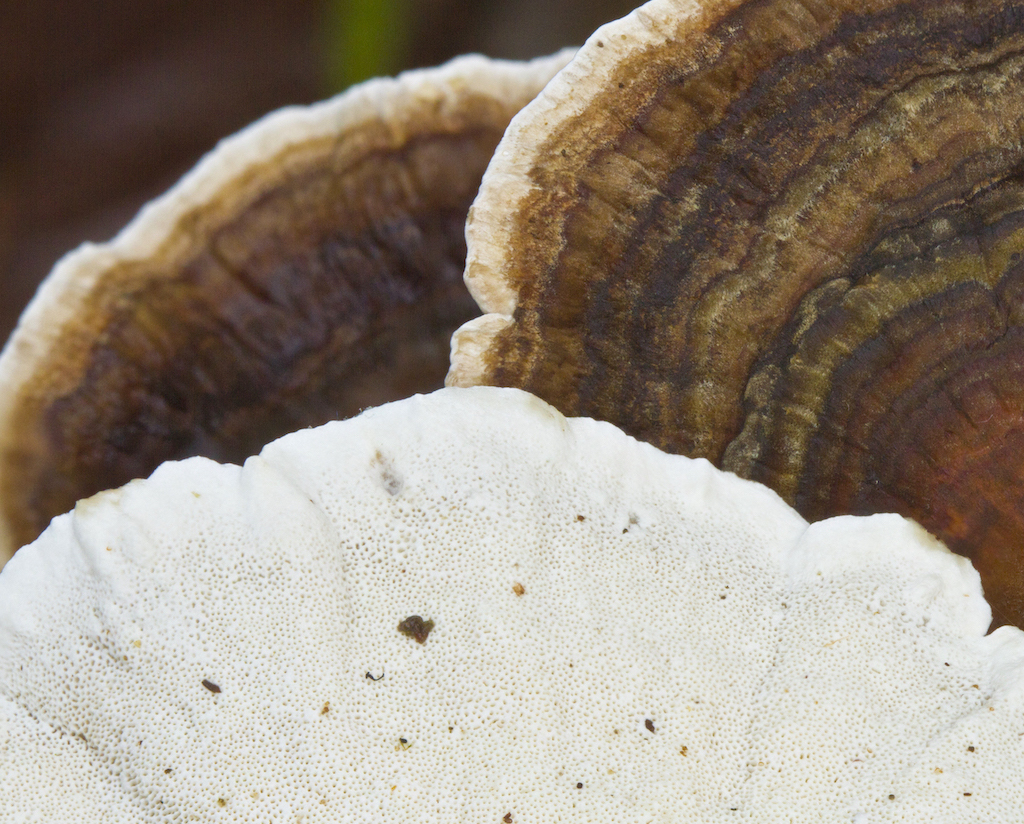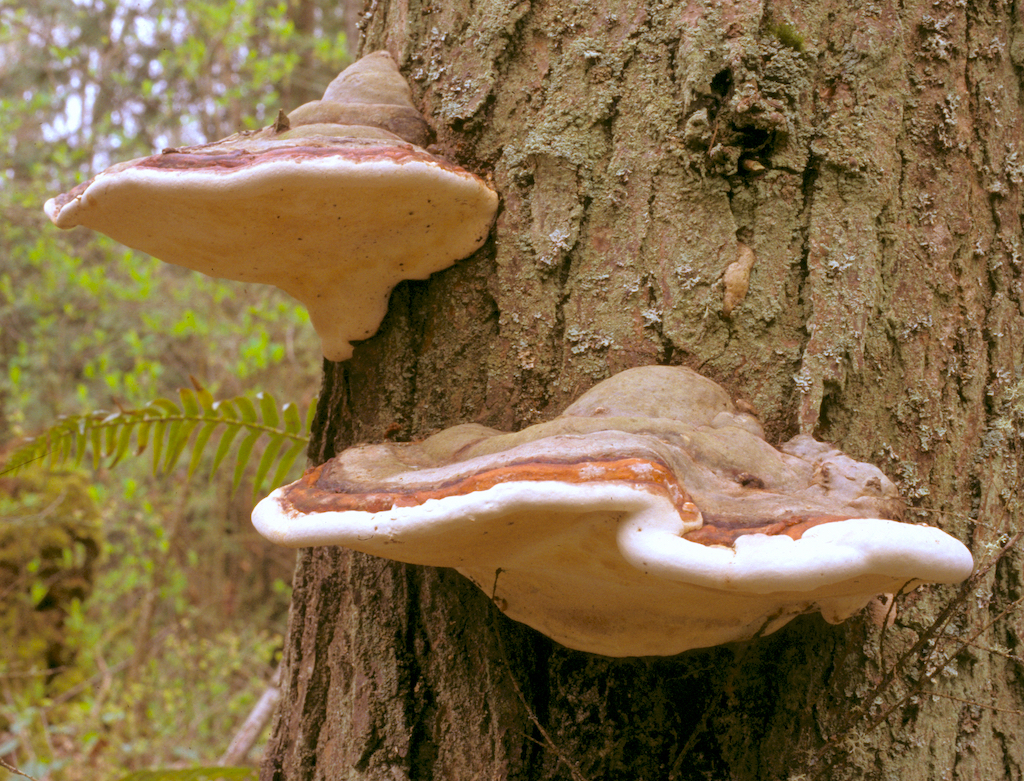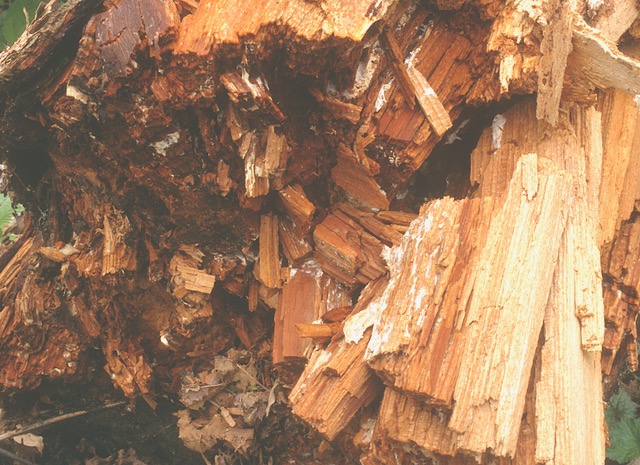by Fred Rhoades
Part 2: Mushrooms That Specialize in Decomposition
In last month’s article (June 2023), I introduced decomposition as being an important ecological role of mushrooms and talked about some of the species that help decay small plant parts: leaves, needles and other small bits. In this article, I will complete the story by talking about decomposers of woody substrates. Wood is a complex structural tissue built by trees and shrubs and composed of annual layers of cellulose and lignin along with many other chemical substances. As a tree ages, the nature of various parts of wood changes: the old wood in the center of the trunk (heartwood) gets filled with a variety of substances, mostly as a waste deposit. This changes the composition, and, thus, it offers a unique habitat for different species. Outer tree bark is composed of dead tissues (not really wood) and offers protection from the environment. A few rotters specialize in bark, but rarely penetrate further to allow entry to the wood proper.
The wood of old-growth conifers of our area can be hundreds of years old. When the plants die, the wood may actually take more than 100 years to fully break down. The fungal species discussed in this article mainly attack deadwood; they cannot gain entry into healthy plants. However, it is often difficult to determine the exact history of a living tree that may harbor some of these — the decay-causing fungi may gain a foothold in trees damaged by other causes: fire damage, insect attack and damage caused by human interference. Fungi that usually attack healthy plants are classified as parasites — we will deal with that approach in another article.
Because of the physical structure of mushroom mycelia and their chemical abilities, mushrooms are well adapted to enter and break down wood. They are particularly important in the breakdown of cellulose and lignin. Forest ecologists who study wood breakdown divide the wood decay fungi into two groups, depending on which of these molecules they specialize in using: brown rotters work on cellulose and leave the lignin, which generally colors the remaining wood brown. White rotters work on both the cellulose and the lignin, but leave some white cellulose. Often, the remains that many of the rotters leave are distinctive enough to have names and the mushrooms involved can be determined from a description of the rot.
Genus Mycena
The genus Mycena includes many species that decompose wood. These are often some of the first small decomposers to show up at the end of summer when temperatures begin to cool. Wood acts as a reservoir for moisture, so, even if the fall rains have not yet started, the species living in and decomposing wood are stimulated to form their spore-producing mushrooms. Mycena haematopus, the “bloody Mycena,” is a commonly occurring species here (Figure 1). The caps are some shade of dark pink or violet, the cap margin has a delicate frilled appearance, and the stems ooze a maroon liquid when cut.
Oyster Mushroom
Another common gilled species of mushroom that decomposes wood is the “oyster mushroom,” a collection of species known as the Pleurotus ostreatus group. The mushrooms in this group are excellent edibles and are easy to identify (Figure 2): they occur on dead hardwoods like maple, red alder and cottonwood, lack a well-formed, central stem and produce light grayish or purplish spore prints. Mushrooms are formed both in the late spring and early fall.
Like many of the rotters that occur on our hardwoods, Pleurotus produces a white rot. In some cases the rot appears as a pocket rot: alternating patches of soft, decomposed wood with harder areas between. An interesting additional feature of this species is that the mycelium actively traps nematodes (roundworms) by producing specialized hyphal branches that narcotize these small animals. The hyphae then grow into and consume the nematode’s interior. This provides this fungus with an extra source of nitrogen in environments that are normally lower in nitrogen.
Polypores
One group of mushrooms that include a great number of wood rotters is the polypores. These produce leathery to woody fruiting bodies and can be found pretty much throughout the year. The group gets its name from the numerous pores formed up into the lower surfaces. The spores are produced on the linings of these pores. Many polypores are opportunistic rotters, their mycelium gaining a foothold in live trees damaged by other forces. But, they linger to continue their decomposition after the trees have died and then fallen over.
A common polypore is the “turkey tail,” Trametes versicolor (Figures 3 and 4) are covered with minute pores and the upper sides are minutely hairy with alternating zones of light and dark tissue. The common name comes from the obvious likening to a fanned turkey tail. This species causes a spongy white rot usually on hardwood trees and logs. Although it can attack weakened living trees, usually it is found on dead wood.
Trametes versicolor is the local polypore with the best reputation for its medicinal properties. Both the fruiting bodies and cultured mycelium have been studied in scientifically controlled clinical trials and shown to be efficacious in boosting the human immune system in its fights against infections and has demonstrated anticancer properties. If one is interested in consuming this natural medicine, I recommend you consult either the Internet or printed resources for further information on preparation and dosage.
Conks
The most common larger, woodier polypore found on conifers in our area are two species in the genus Fomitopsis. F. mounceae (red-belt Fomitopsis) is the most common species and is recognized by the wood-hard “conks” with a deep orange band around the uppermargin (Figure 5 ).
The fruiting bodies are perennial, lasting a number of years while the fungus continues to decay the wood. Each year a new layer of spore-producing pores is added to the underside of the fruiting body. The mycelium of this species causes a recognizable “cubical brown rot” in the dead wood (Figure 6) because of the way the rotted wood breaks up along lines of weakness as the wood shrinks when the cellulose content is used up.
Western Chicken of the Woods
In the late summer and early fall, when the temperatures begin to drop, a striking species, Laetiporus conifericola also causes a brown rot on conifers (Figure 7). A large fruiting of this unmistakable species can be a sight to behold when coming on it unexpectedly: fresh specimens are bright orange-red with an underside of lemon-yellow pores. This mushroom is known as the “western chicken of the woods.” It is edible and highly regarded by many. One just eats the outer inch or so of the soft edge of the fruiting body, being sure it is well cooked. I think it is overrated, but perhaps I haven’t had the right chef prepare it for me.
Like the “turkey tail,” the fruiting bodies of “chicken of the woods” are annual, produced once a year, but will be produced for several years running while their mycelia do their decay. After spore production is finished, the fruiting bodies slowly decompose, turning white and falling off the tree. If you find a mass of spongy, white fruiting bodies on the ground under a tree, make a note and come back earlier in the following year. You may be lucky enough to see this magnificent fungus fresh.
Artist’s Conk
On live and dead hardwoods (occasionally on conifers) one often finds the “artist’s conk,” Ganoderma applanatum (Figure 8). It causes a mottled white rot (lignin and cellulose used).
This species often produces so many brown spores that they leave a trail on the ground under the fruiting bodies out into the woods. The common name refers to the unusual characteristic of the pore surface on the underside of the fruiting bodies. Pressure from a stylus or even a hard fingerprint causes the creamy white surface to darken brown. An accomplished artist can produce wonderful drawings once they figure out the nuances of this medium. Once a “drawing” is produced, if the fruiting body is dried slowly, the artwork is permanent.
Position of Pore Layer
The final picture (Figure 9) in this article illustrates a story that the polypore fruiting bodies often tell. In this case, the mycelium of Ganoderma applanatum has lived for several years in this maple tree log and the position of the fruiting bodies (conks) tell of the history of the positioning of this tree during its decomposition.
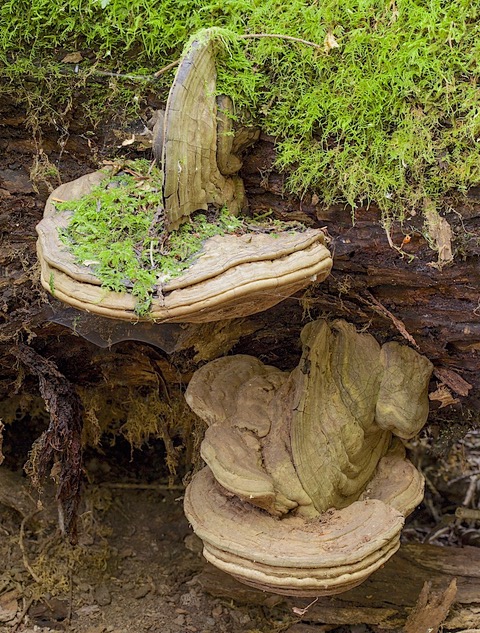
Figure 9. Artist’s conk fruiting bodies have changed their orientation as position of decaying tree changed.
All of the gilled fungi, the boletes and the polypores orient their spore-bearing tissues so that the spores will fall out below the fruiting bodies. In this case, the position of the pore layer tells us how the tree was oriented when that part of the fruiting body was made. The upper set of fruiting bodies shows one with pores oriented to the left and another down. Thus, at some point the tree (trunk base to the left) was standing when the decomposition by Ganoderma began. Then, the tree fell over. But, the lower set of fruiting bodies adds to the story because the middle of the three conks there is at an angle somewhere between the other two. Thus, the tree likely was propped up at an angle for a year or two before it completely fell over on its side.
__________________________
Dr. Fred Rhoades from 1977 to 2009, was an instructor of biology at Western Washington University.

